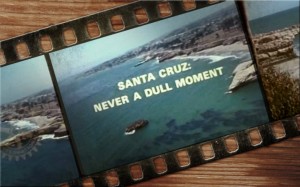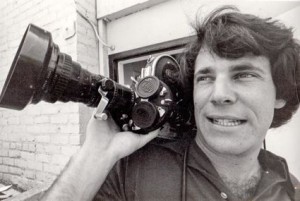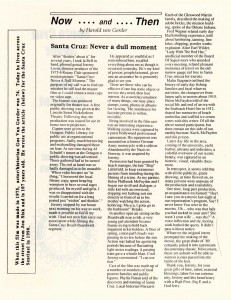 In 1974, Jeremy Lezin was living in Los Angeles, just out of film school and trying to figure out how to make films.
In 1974, Jeremy Lezin was living in Los Angeles, just out of film school and trying to figure out how to make films.
When he made a trip home to Santa Cruz, an opportunity fell into his lap.
“I was contacted by the Santa Cruz Rotary Club about making a film. They showed me an awful example from a Canadian city and asked if I could make something like that,” Lezin says. “I said, ‘no, but I can do better.’”
The Rotary Club offered him $5,000 (rather reluctantly — Lezin says the project was one man’s dream idea, and he had to fight the other members to see it through), which covered most of the production, but Lezin was still $500 short. So he contacted a couple local businesspeople, including Tanner Wilson of Wilson Brothers Commercial, and asked them for contributions over a two-martini lunch.
“I staggered out with the funds necessary to complete the film,” Lezin remembers.

That result was “Santa Cruz: Never a Dull Moment,” a collection of sublime aerial shots of the area, interviews about the town’s history, and a patchwork of the different cultural influences that make up Santa Cruz.
“It was a wonderful experience for me, to write, shoot, direct, narrate and then cut this film,” Lezin says. “I picked representatives from different areas of Santa Cruz’s history and had them speak on camera. All but one of these folks are gone now.”
Santa Cruz: Never a Dull Moment
Here’s a timeline of some of the best moments in the film:
0:00 – Aerial view of Steamer Lane and West Cliff Dr.
0:40 – History of the Ohlone Indians in Santa Cruz
0:57 – View of Natural Bridges (before the 2nd arch fell)
1:15 – Learn How Santa Cruz got its name
2:25 – Santa Cruz Mission History
3:48 – Fred Wagner discusses Santa Cruz’s industrial period
7:32 – Stagnaro Family / Fishing History in Santa Cruz
8:25 – View of 3 wharf’s (Henry Cowell Wharf, Railroad Wharf, Casino Pleasure Pier)
9:40 – History/Evolution of Local Transit System, and the transition from horse-drawn cars to car lines that took people from Twin Lakes to Capitola for a dollar.
10:35 – View de l’Eau Streetcar Station (Gazebo) at the end of Woodrow Ave.
10:45 – Sea Beach Hotel “This is the end of a really elegant era.”
11:58 – Casino & Main Beach
13:15 – Alice Earl Wilder, the “undauntable grand dame of local politics,” reminisces about visiting Santa Cruz by train as a young girl
16:10 – Downtown Santa Cruz. See what Pacific Avenue looked like before the 1989 earthquake. A lot is different, but the abundance of street performers is one lasting similarity
16:39 – Cooper House
17:45 – UCSC. This segment about the university is interesting for both its similarities to and differences from the present day
18:50 – Monte Carlo House (also known as the Golden Gate Villa)
19:20: Lezin talks about the “West Coast Renaissance,” happening in the 70s
20:40: Surfing at Steamer Lane
22:15 – The Boardwalk. Even the boardwalk looked a little different in 1974
Lezin eventually moved back to Santa Cruz for good after making the film, and says he wouldn’t trade it for anything.
“I always joke that Santa Cruz is like the three bears story, “It’s not too (hot, crowded, cultural) and it’s not too (cold, country, remote),” he says. “It’s ‘just right.’
For example I saw a Shakespeare play last night at UCSC and it rivaled anything that I saw in Ashland, OR. We have it much better than we know.”
Photo Credit: Jeremy Lezin
 Harold Van Gorder, one of the actors in the film (the man from the scenes at the Boardwalk), wrote an article for the Santa Cruz Sentinel years after the film was produced. His article recalls fond memories of the filming, and of the filmmaker, Jeremy Lezin. It’s a great footnote to this now classic Santa Cruz documentary.
Harold Van Gorder, one of the actors in the film (the man from the scenes at the Boardwalk), wrote an article for the Santa Cruz Sentinel years after the film was produced. His article recalls fond memories of the filming, and of the filmmaker, Jeremy Lezin. It’s a great footnote to this now classic Santa Cruz documentary.